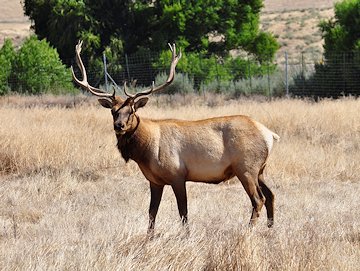
Tule Elk - California State Parks Photo
Andrew Cole and I were driving south for a Youth Football event and had a chance to photograph these Tule Elk grazing in an Alfalfa field along U.S. 395 approximately 6.5 miles south of Big Pine.
This 2009 video tells the history of Tule Elk.
Viewing areas along U.S. 395 at these alfalfa fields and a viewpoint above the nearby Tinemaha reservoir give tourists a chance to see a herd of Tule Elk. Not indigenous to the Owens River Valley these dwarf elk rather come from the San Joaquin Valley and coastal areas where the introduction of cattle and hunting nearly drove them to extinction.
Legislators realized the danger of extinction and gave them protection in 1873. Although the elk began to recover, their raiding of crops was considered to be a nuisance by San Joaquin Valley farmers. 55 animals were transplanted to the Owens Valley in 1934. The herds flourish on protected Los Angeles Department of Water land and in Inyo National Forest. Some have been transplanted back to other parts of the state.
An interesting set of pictures taken in October 2005 is found here: www.billpounds.com/ovelk/ovelk.html
Here are the pictures that Andrew Cole and I took on September 29, 2006.
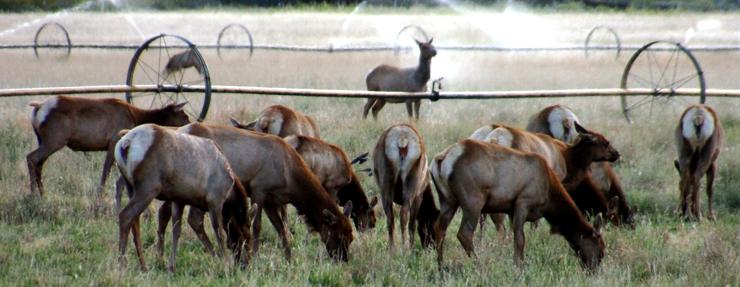
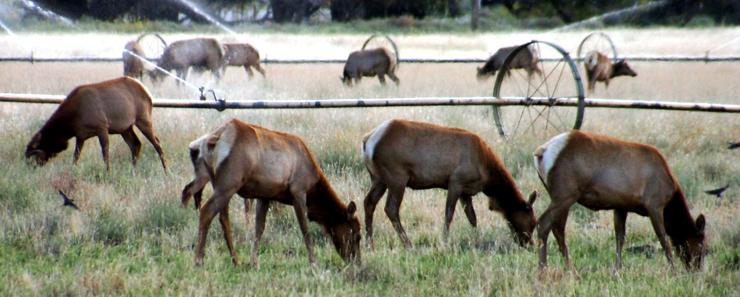

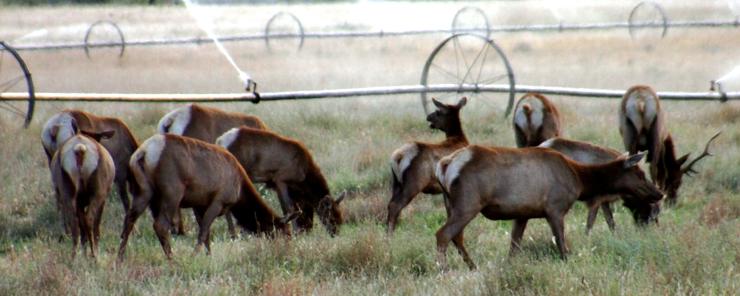
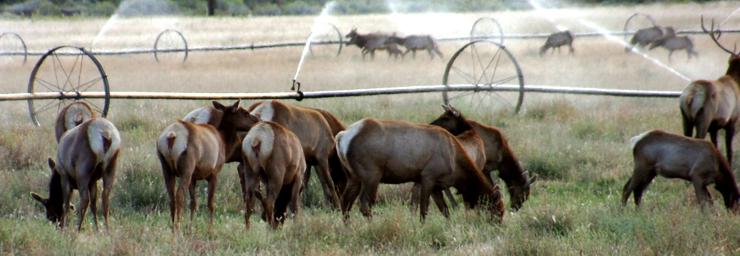
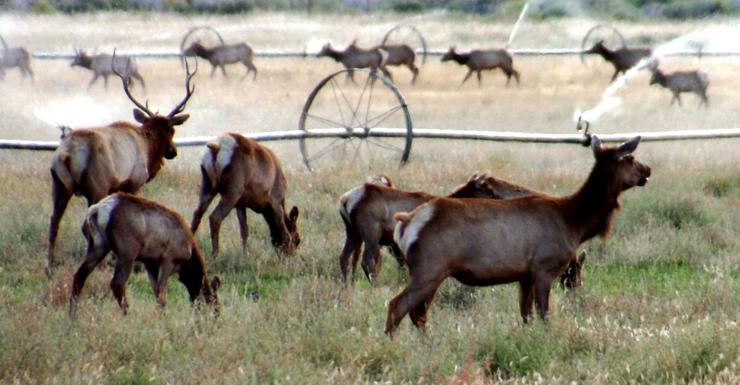
A Brief History Of The Owens Valley Tule Elk

Henry Miller
The Tule Elk is a rare animal, found only in California. Confronted by hunters and ranchers, they were driven to the brink of extinction in the early 1870's. Hunting pressure had virtually eliminated the Tule Elk from the San Joaquin Valley, but Henry Miller, the wealthy rancher who founded the once-vast Miller-Lux Cattle Company, protected a small band of the animals, which were found, on his ranch.
From those meager times, the Tule Elk has slowly recovered. Today (2011) there are 22 herds in California, which total approximately 3900 animals.
The Owens Valley herd has created an on-going and often bitter controversy. When the Tule Elk were introduced into the valley, the Department of Fish and Game set a population limit on the herd of 490 animals, in essence an estimate of the Valley habitat's carrying capacity. The limit of fewer than 500 animals for a habitat, which exceeds 200,000 acres to some, seems unjustified, but considering the low productivity of the arid valley, it is probably close to an accurate appraisal of how many elk the range can adequately support. In the spring of 1980, the Owens Valley herd exceeded 490 elk, and the biologists at Fish and Game advocated a thinning program to reduce the number back to 490. Several strategies were evaluated for culling the herd, but the least expensive was a selective hunt conducted by Fish and Game personnel.
The original Fish and Game Code, which set the 490 animal limits on the Owens Valley herd, also prohibited the killing of any Tule Elk unless the total statewide herd exceeded 2,000. Discovering the dilemma (the statewide total at the time was far below the 2,000 mark) Fish and Game officials found themselves with 92 surplus elk, no place to put them and a healthy population that gave every indication of continued growth. After repeated attempts to place their excess animals, the biologists found room for limited numbers of the animals at the Concord Naval Weapons Station and at Point Reyes National Seashore. The Point Reyes placement has created its own controversy since at least one dairy farmer was displaced from Federal land that had been under long-term lease in order to make room for the elk. It is the opinion of Fish and Game officials that it is only a short time until all of the available sites for resettlement are filled and yet the statewide herd remains below the 2000 individuals necessary for herd culling. This has all of the trappings of a protracted environmental dispute.
2011 Update: According to a California Fish and Game representative, the current population of Tule Elk in California is about 3900 in 22 herds. See the links at the bottom of this page for more information.
History of Tule Elk in California
adapted from California State Parks 2011 brochure for the Tule Elk State Reserve
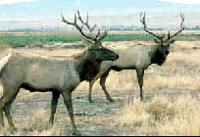
Tule Elk - California State Parks Photo
The deep trough of the San Joaquin Valley begins south of Redding and stretches 430 miles along I-5 past Bakersfield. At the valley’s south end, 22 miles west of Bakersfield, Tule Elk State Nayural Reserve protects a flourishing species of elk that was once hunted nearly to extinction.
Though spring and fall are pleasant, the elk are at their most interesting during the hottest days of summer, when temperatures can reach 100 to 115 degrees. However, until the heavy winter rains begin, opportunities to view and photograph the elk are still good.
NATIVE PEOPLE AND THE TULE ELK
For thousands of years the Southern Valley Yokuts lived stable lives, thanks to an abundance of waterways. Tule reeds provided building materials for houses and boats, and their roots and seeds were edible. Acorns, various nuts, seeds, leaves and berries, and a variety of fish, game and fowl rounded out their diet.
Because antelope, deer and smaller animals were easier to catch, the native people rarely hunted tule elk. Thus for thousands of years the elk thrived and multiplied, ranging from Shasta County in the north, to the base of the Tehachapi Mountains in the south, east to the oak-grasslands of the Sierra Nevada foothills, and west to the Pacific, between Point Reyes and Santa Barbara. This subspecies of elk was the predominant form of animal life in the Central Valley, comparable to the bison of the Great Plains. They normally form herds of 40 to 60 animals, but they were so numerous in the northern San Joaquin Valley that herds sometimes numbered one to two thousand.
DECLINE OF THE SPECIES
Because predators—grizzly and black bears, mountain lions and coyotes—were a threat only to very young, weak or crippled elk, it was probably the food supply that limited the elk population, particularly in drought years. European grasses, introduced in the late 1700s to mid-1800s, compromised the elks’ grazing areas. The elk, deer and other animals living on the grassy marshland and oak savannah were now competing with horses and cattle for grazing resources.
Serious commercial exploitation of tule elk began during the early 1800s, when they became part of the hide and tallow trade. In 1827 the fur trade brought hundreds of professional hunters called the "fur brigades"—who wintered in the Central Valley because of its relatively mild weather and excellent grazing and hunting opportunities. They shot elk by the hundreds and drove them from the open prairie into the tules. By 1845 about 3,000 elk and deer hides a year were exported from California.
Nevertheless, tule elk were still plentiful until the gold rush brought thousands of new immigrants to California. Seemingly overnight the demand for meat increased greatly. Some 49ers found it more profitable to hunt than to work in the mines; by 1850 the entire Sacramento Valley tule elk population had been wiped out. In the San Joaquin Valley, where hunting was less common, the elk survived somewhat longer. However, in 1863 market hunters claimed to have killed the last elk cow and calf left in the tules of the San Joaquin Delta. The remaining elk range was now the willow- and tule-filled marshes between Buena Vista and Tulare Lakes. Gradually this refuge disappeared as the area was diked, drained, and cleared for agricultural use.
PRESERVATION OF THE SPECIES
In 1852 the State Legislature passed a law limiting elk hunting in specific counties to six months of the year. The law became statewide in 1854, with no provisions for regulation or enforcement. When the lawmakers banned all elk hunting in California in 1873, there was doubt that any tule elk still existed.

Henry Miller
However, in about 1874 or 1875, a single pair of elk was observed in the tule marshes near Buena Vista Lake. A.C. Tibbets of the Fish and Game Commission believed they were the last of their kind. And indeed, over the next few years as the marshes were drained and the land put to agricultural use, very few elk were exposed to view. In 1895, after 20 years of protection, a precise count revealed that there were just 28 tule elk left in the world.
It was Henry Miller of the Miller and Lux cattle empire who was most responsible for preserving the tule elk. He issued orders to his employees to protect the animals, most of which were ranging Miller and Lux land, and offered a $500 reward for information on anyone disturbing them. Tule elk numbers increased rapidly after 1895; by 1914 they were doing an estimated $5,000 to $10,000 damage to Miller and Lux crops annually. Miller continued to protect the elk though he asked that the herd be limited to 400 animals. With the help of the U.S. Biological Survey, the California Academy of Sciences, and others, Miller attempted to relocate elk to public parks and zoos. Most of these operations were failures, although they led to the creation of two wild, free-ranging herds—the Cache Creek and Owens Valley herds. More than 3,700 elk now range in some 20 herds in California.
THE TUPMAN RESERVE
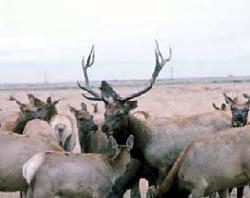
Tule Elk - California State Parks Photo
As early as 1912 proposals were made to provide a fenced preserve near Buena Vista Lake in Kern County to prevent more serious conflict between tule elk and local agricultural interests. In 1930 the Miller and Lux ranch owners provided 600 acres as a temporary holding area until a state-sponsored refuge could be established. In 1931 the legislature passed a bill to establish an elk sanctuary, and in March 1932 the State Park Commission purchased 953 acres near the town of Tupman. By the end of August the new Tupman Reserve was completely fenced, and elk from the Miller and Lux enclosure were moved to the new site. The state agency then known as the Division of Fish and Game, assigned to operate the sanctuary, began by rounding up most of the free-roaming elk so that about 140 elk were finally enclosed.
The sanctuary was a fairly good example of the natural habitat of free-roaming tule elk. The Buena Vista Slough along the sanctuary’s southern edge, with its rich growth of riparian vegetation, provided water. However, the acreage could not support 140 tule elk. The situation worsened in 1952 when the Isabella Dam on the Kern River virtually eliminated seasonal flooding in the Buena Vista and Tulare Lake areas of the San Joaquin Valley. On the reserve the once lush riparian habitat along Buena Vista Slough disappeared.
In 1954 management of the 41 surviving elk was turned over to California State Parks which devised a feeding program to keep them in good health. Artificial ponds allowed the animals to cool off during the heat of summer by indulging in their favorite sport of "wallowing."
Today the reserve is no longer a good example of natural tule elk habitat. California State Parks is looking for ways to provide a more spacious and appealing natural environment for the elk. New management and development programs are currently under consideration, but the best long-term solution may be to locate a new and considerably larger reserve in which to protect and interpret the tule elk.
THE ELK
Three kinds of elk are native to Western North America. Roosevelt or Olympic elk from northwestern California and western Oregon and Washington are thought to be the largest. Also larger than tule elk, the Rocky Mountain elk, from the Rocky Mountains and Great Basin, have been introduced into Monterey, San Luis Obispo, and Shasta Counties, as well as into a herd enclosed at Tejon Ranch in Kern County. The smaller tule elk are lighter in color and have shorter coats, larger teeth and various other characteristics that help suit them to their warm, dry natural habitat.
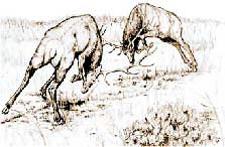
Tule Elk - California State Parks Illustration
The herd shares a loose, flexible, but well-defined social order. Relationships are established, developed and maintained by activities such as eye contact (e.g., the direct stare) or fights that may involve rearing and boxing with forelegs. Among the males there might be full-fledged, head-to-head combat with antlers, though most conflicts are resolved by more subtle forms of testing. Since social and cooperative herd behavior protects against predators and ensures survival, the inherited ability of tule elk to work together in a herd is as vital as more obvious physical factors like size and color.
Communication within the herd is complex and involves all of the senses, though smell seems to be the most highly developed and vital. Voluntary and involuntary sounds and visual signs are used to maintain and coordinate activities. While grazing, for instance, each animal receives and passes along information on the nature and direction of possible threat through signs and signals that may seem trivial to a human observer. Even a gentle wind may disrupt the normal pattern, making the entire herd nervous and edgy. Chewing, digestive tract noises—even the faint creak and clicking made by the animals’ hooves—play a role in the quiet symphony of sounds and sights that keeps the herd moving as a unit.
THE ANNUAL CYCLE
Molting—Each spring tule elk shed their old coats for short, sleek, reddish new ones. By October and November this new coat is fully grown and has faded to the light buff color characteristic of tule elk.
Antlers—Only males carry antlers, which are cast each year in late winter and then regrown. Antler size increases until about the sixth or seventh year. During regrowth they are covered with velvet and are sensitive and easily damaged. Velvet is shed in late July or early August before the rutting season.
Rutting—Many behavioral and physiological changes precede the breeding season between August and early October. In July adult bulls join the cow herds. Eventually the master bull drives all other bulls from the herd and concentrates on keeping rivals away from his harem. When the constant demands of herding, defending, fighting and breeding reduce the vitality of the master bull, he will be driven off and replaced. This fascinating mating process is attended by bugling, antler thrashing and a variety of other forms of behavior characteristic of elk around the world.
Calving—Calves are born in April and May, after a 250-day gestation period, weighing about 20 to 25 pounds. The cow leaves the herd at the time of birth and remains more or less solitary until the weak, helpless calf is strong enough to run with the herd. The calf rapidly gains strength, and within a few weeks it can run swiftly with some endurance. Calves shed their spotted coats at about four months. Nursing continues until about September, though the calf begins to graze for itself a few days after birth.